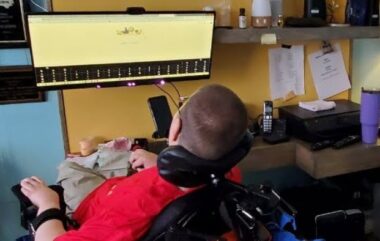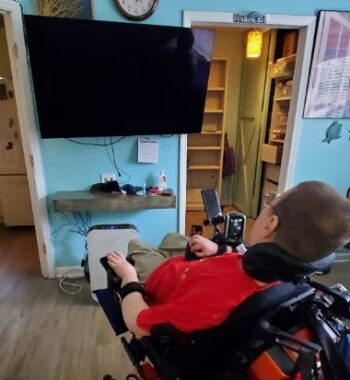Transforming our homes into adaptive living spaces

Back in July, I wrote about the small apartment my mom and I used to live in before we moved into a new home when I was 13. In the new house, I have a better bedroom and bathroom, my own kitchen, and a medical supply room — all of it separate from my mom’s side of the house.
As a new teenager, it was pretty cool to have my own bachelor pad. Now that I’m 42, my heartfelt connection to my living space has a much deeper significance.
My rooms have become like a physical timeline of my life. In other words, my living space has changed a lot in the past three decades. We started out with a basic template of what any living space would need. Then technology progressed and we connected with people who could modify my rooms. Fantastic new features and capabilities transformed my space, giving me more independence as I live with SMA.
When we moved into the house in 1995, my rooms were pretty plain. My bedroom had a bed, a chair for my nurses, and my power wheelchair that I drove around during the day. The wheelchair was (and still is) charged in my medical supply room at night.
In 1997, I added a desktop computer that I constantly use. Before that, I had a small, basic stand with a TV.
My current setup
When I first got a computer, we put it on a simple stand. In 2002, I got a huge computer desk. It was fancy but stuck out pretty far and took up a lot of space in my room. I also got a tall TV stand with a lot of storage compartments. It was beautiful but also took up a lot of space.
All of that changed about a decade ago. One of my nurses, who’s been working with me for 15 years, is handy with construction. He completely changed the design of my rooms. Instead of a big, bulky desk, he built me an elegant computer workstation that lies almost flat against the wall. It has shelves for storage that don’t stick out very far.

Ari Anderson’s nurse built him a computer workstation that saves a lot of space. (Courtesy of Ari Anderson)
We ditched the TV stand and attached the TV to the wall opposite my workstation. For storage, my nurse placed a wooden beam underneath the TV. It’s long, so it has a lot of room to place things on it, but it doesn’t stick out far, either.
These modifications gave me a lot more room to maneuver my chair. And not only do I have a functional computer workstation where I can do all of my advocacy projects, but it also makes my room look cool. The same goes for my TV space in the bedroom.
My nurse also installed Kasa Smart switches and dimmers, which allow me to control the lights and a fan with an app.
All of this is only a fraction of the great things about my bachelor pad.
Looking toward the future
As happy and comfortable as my mom and I are in this house, life has a way of leading us down unexpected paths. After 29 years, circumstances have made it more advantageous for my mom and me to move into a new house with my sister and her family.

Ari’s TV and shelf, which match the style of his workstation. (Courtesy of Ari Anderson)
By advantageous, I don’t mean my sister and her family are taking care of me. That will still be left to my mom and my nurses. We simply want to be enriched by sharing our lives with family under one roof.
We bought a multigenerational house about 10 minutes away from our current home. The goal is to be moved in by the first week of October.
Just like we did 29 years ago, we are turning the garage into my own living space, with a bedroom, bathroom, kitchen, and medical supply room. We are taking apart what works in my current space, like my workstation, and moving it to the new place. A lot of other awesome projects are in the works that will help increase my independence even more. I’ll write about those soon.
I have faith that they’ll serve as an example for others who need adaptive living spaces. Together, our independence can soar to new heights!
Note: SMA News Today is strictly a news and information website about the disease. It does not provide medical advice, diagnosis, or treatment. This content is not intended to be a substitute for professional medical advice, diagnosis, or treatment. Always seek the advice of your physician or other qualified health provider with any questions you may have regarding a medical condition. Never disregard professional medical advice or delay in seeking it because of something you have read on this website. The opinions expressed in this column are not those of SMA News Today or its parent company, Bionews, and are intended to spark discussion about issues pertaining to spinal muscular atrophy.
The post Transforming our homes into adaptive living spaces appeared first on SMA News Today.




